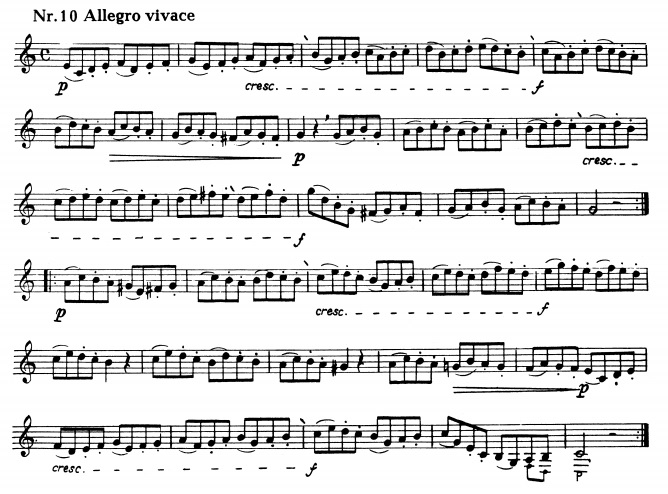Music
If you haven’t read my walkthrough of Kopprasch #3, while you can get a copy of the Kopprasch’s 60 Low Horn Etudes for free from IMSLP.org I do recommend that you eventually purchase a copy. It’s much easier to have a bound book than a series of loose sheets, and sometimes the editing on the free version leaves a little (or a lot) to be desired. Here is the IMSLP version of Kopprasch #10
 Key Points
Key Points
- The tongue-two-slur-two pattern (it is actually more correctly a tongue-three-slur-one pattern, but that’s mostly just semantics) is one of the big challenges in this etude.
- Unlike some of the other Kopprasch etudes, this one features scale patterns that incorporate both small leaps and steps. Often it is one leap up two steps down OR one leap down and two steps up. The pattern does get broken a few times, but it mostly holds true.
- The range is once again the typical range expected from a low horn player – a bit above the staff down to the C3 (one octave below middle C).
- The dynamics are fairly predictable – aside from a singe subito change (in bar 14), everything else is fairly gradual and mostly follows the melodic contour.
Technical Tips
- For the slur-two-tongue-two pattern: Start off slow, and consciously shorten or clip the 2nd note of the slur (i.e. the one that you are not tonguing) with your air (NOT with your tongue). While this is not the best habit to get into once you are speeding it up, I find that many people play the 2nd slurred note too long, and so it messes up the articulation of the first staccato note. Like I mentioned in the Kopprasch #3 walkthrough – articulation in these etudes is crucial – make sure it is crisp! Remember that even the staccato notes should be connected by a continuous air stream! Once you are able to go a little faster, worry less about clipping the 2nd note of the slur – if you are practicing with a metronome it should reach an appropriate length without much conscious work.
- Know your scales and arpeggios: Although the majority of this etude is still scales, the two note skips are all part of arpeggios, so the better you know them the more easily your fingers and eyes can keep moving. If you don’t know them, download a 1- or 2-octave scale/arpeggio sheet and learn them!
- Use a metronome: Unless you have hours of practice time to spin your wheels – make sure you are using your practice time efficiently! The metronome will help iron out any finger timing or lip/air slur timings that aren’t quite locking in, and show you which scales (or parts of scales) are the most difficult for you.

